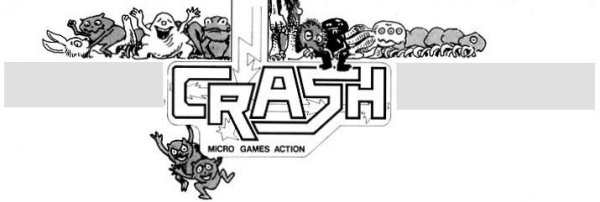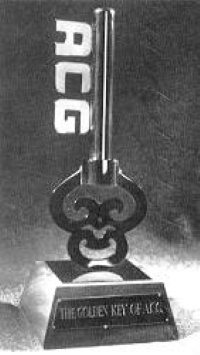


Since the item on the Golden Key of ACG was written, the superb trophy has arrived — and it stands 14 inches high on its base. Watch out for the next issue, where the winner will be announced! In the meantime, plans are afoot for a follow-up competition from Ultimate based on Sabre Wulf. Watch out for details — next issue.
The response to our draw an Atic Atac map competition has proved to be enormous. As I write this, Timothy Stamper of Ultimate tells me that the prize is being cast. The trophy of the ACG key stands twelve inches high. It won’t be long now before the winner’s name emerges.
Meanwhile, from the wealth of detail sent in already, our colour poster is being prepared. Part One may be found in the centre of this month’s issue, with Part Two to follow next month. All you have to do is carefully lift up the staples and pull the two centre pages out. Part One contains the Attic, First Floor and Ground Floor. Part Two has the Basement and the Caverns. The two parts assemble longways one above the other to make up a finished poster approximately 297mm wide by 840mm high.
There must still be people around who will find the map useful as a guide to playing Atic Atac, but for those who already know the place inside out, we hope the poster will make an interesting decoration and provide a memory of hours spent undoing what Ultimate has wrought!
I was interested in the reaction of a caller who, in passing, commented that CRASH so often concentrated its reviews on smaller, often unknown, software houses. There was the implication in the tone of his voice that this was something of a failing — rather as though we were unable to get games to review from the bigger, more important companies. Or perhaps it was a reference to the lack of good games in summer. Whichever, it has to be said that CRASH set out to be a comprehensive review magazine (that can be difficult at times, but we do our best) and as such is duty bound to review games from any sized software company when and as space allows.
Besides which, even the biggest software houses today were all little ones a year or two back. Who is to say that some genius operating from his or her back bedroom today won’t be a giant come Christmas? It’s the ideas that count. What is a problem for the young and unknown software house is exposure — letting people know that they’re there. Almost every magazine in the business will devote space instantly to Jet Set Willy and Sabre Wulf, but who apart from the specialist mags will bother with Dennis Through the Drinking Glass or Application’s follow-up The Tebbit? I know that the majority of readers are only interested in the ‘biggies’, but it can lead to missing out on a lot of very good and entertaining games. In CRASH we try to redress the balance a bit.
On top of that it would be a good question to ask — do the ‘biggies’ always come up with the goods?
Running on from the above piece, small and large software houses alike are now facing the traditional summer slump. It may seem odd to talk of a tradition in a market barely in its third year, but experience indicates that the summer is always poor for software sales. Not unnaturally, games players who would have to be dragged away from their Spectrums in the dark winter months find that there are more interesting things to do outdoors during the summer. Consequently, less software is bought and loaded.
Last summer, less wary, the software houses carried on advertising in the magazines and were then upset when they found that the sales figures didn’t equal the advertising bills. This year, everyone is acting more cautiously, looking over their shoulders at the circulating rumours that so and so is about to go under. Naturally, the slump hits the smaller companies with less funding much harder, but one or two of the real ‘biggies’ don’t seem to find it easy to pay for their advertising bills either.
The records do show that sales of games drop in the summer, but perhaps the software houses are helping to perpetuate a vicious circle by hibernating. This is considered a poor time to release new games. I write this on the eve of seeing Ultimate’s new game, Sabre Wulf. It might be salutary to remember that Sabre Wulf is only Ultimate’s seventh game, being released in the summer, and that their first two, Jetpac and Pssst were launched about a year ago right in the middle of everyone else’s slump. As a result of their experiences across the year, they are probably quite unconcerned about releasing a major game (with a new price too) in the middle of summer. It highlights a fallacy in the theory that a good product should be saved up until Christmas — with a lack of good games to buy and play, any really good game released will stand out — and be bought. But if there is a tendency to pull in the horns during the summer and not release good games, then the buyers are going to bother even less, thus tightening the vicious circle.
The Hotline is hotting up! Calls coming in now are virtually swamping the system, especially with the advent of the adventure line. Each month now results in thousands and thousands of calls — a lot of person-hours to enter the details into the computer for analysis. Fortunately most callers know their minds and state their business efficiently. But there are the ‘gigglers’. These fall into two broad categories — those who start to giggle, put a brave face on and somehow get through (a subgroup are those who break down completely but manage to ring back minutes later and get through the rigmarole okay); and then there is the second group who probably never intended a serious vote in the first place, start giggling, then turn the call into something else altogether. It’s just as well that the team taking the details are broad-minded! Unfortunately this telephonic incontinence wastes a lot of time, especially when you get a bunch of people with unlimited funds for the phone who like to ring continuously and practice their party jokes or Capital Radio’s DJ of the year competition entries. It’s funny how the thought of an unmanned answering machine attracts the attentions of bored people! Still, when there’s the time, these calls can provide hours of amusement at the CRASH offices. But we would prefer to just get the votes!
Roger Kean
The winner of the CRASH Questionnaire draw was J.S. Underhill of Bromley, Kent, who wins £50 worth of software of his choice plus an ubiquitous CRASH T-shirt. The three runners-up each get a T-shirt plus a three-month subscription to CRASH. They are Philip Brown from Hove, East Sussex, Christopher Powell from Oswestry, Shropshire, and Kevin Speiers from Croydon, Surrey.
I would like to thank all those who took the trouble to fill out and send in the forms, which are still being collated for a final result.
By G.G. Watson

As you lean back in your chair, monsters stare out at you with their glowing multi-coloured eyes. Space ships zapping anything, or anyone in their way, streak through sectors of the galaxy never visited before. Robots stumble across alien landscapes, tanks rumble through the ruined remains of planet Earth. Racing cars speed round and round. Frogs and all manner of creatures and entities hop and leap across imaginary dreamscapes. Evil beings and wizards cast their spells in devilish plots to enslave humanity. Unprotected man has only his wits to keep him alive.
No, this is not the scenario for a complex new computer game! It is a subjective impression of the garish, sensational software advertisements contained within the pages of any popular computer magazine you might care to mention.
How exciting the new world of the home computer looks! These sparkling images entice us to immediately go round to our nearest computer shop to part with our money. Yes, be the first to own the electronic game which will strain the skills and intelligence of you and your friends to their limits. Dazzle the neighbourhood with this brilliant new toy. Those are some of the things advertisements tell us.
Even negative reviews of a game cannot quite convince us that it will not spend much time on our television screen if the advertisement in all its glowing imagery has hooked our interest.
The advertisements for computer software, and hardware, are slick and professional. It is only a pity the games and machinery that they sing the praises of so well do not always quite live up to their inflated and verbose lyrics. Which leads me to wonder if the people who produce the advertising artwork and literature should perhaps try to educate computer programmers and designers how to produce material that has an equal impact on our senses.
Many commentators have noted the parallels between the computer software industry and the pop music industry. Indeed, some computer companies have encouraged this comparison by attempting to make their programmers into ‘stars’.
Although this reflects the fast growing popularity of home computing and its status as a form of entertainment, it also means that hype and image become more important than the product.
Taken to its extremes, can we one day expect to see screaming teenagers chasing after the programmers of their favourite games? Will prime time television shows feature the ‘Top of the Floppies’ and contain promotional videos of programmers dancing Michael Jackson-type steps across back-projected images of their latest game?
This might sound funny but it is not long ago that many games were produced in houses, garages, and crummy little offices. Now plush office suites and expensive, extremely fast, sports cars which lurk outside in the executive car park, are the order of the day.
At the moment the software industry is booming and new talent is quickly utilised and promoted, just in the same way as the pop music industry grew and developed in the Sixties. But whatever happened to the music scene in the Seventies? It plummeted to the depths of banality and had to be knocked into sense by the punk revolution! Is this what will happen to the software industry in the Nineties or late Eighties? Will the hype and image being generated so carefully now kill off the creative flair and instinct that still survives today?
Only time and the consumers will hammer home the answers to these questions, let’s hope everyone concerned will fare better than most space invaders or pacmen!